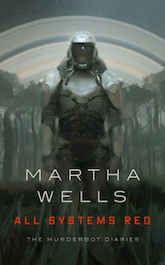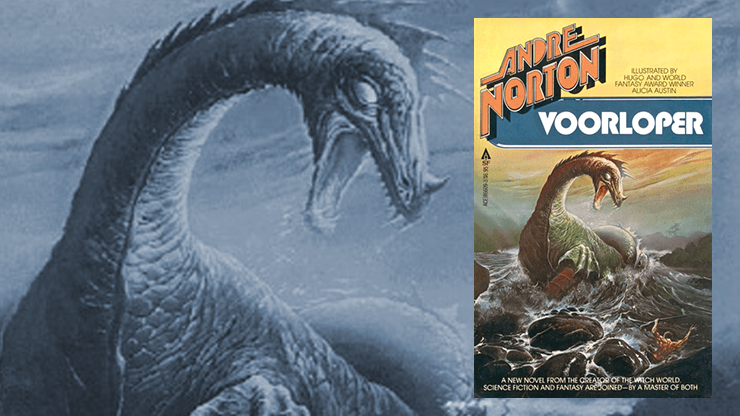The title of Voorloper keeps tripping me up. The word refers to an itinerant human trader on the planet Voor, but I keep reverting to the conviction that it’s an ungainly alien creature à la the bog lopers of the Witch World. It’s disconcerting, especially since the edition of the novel that I have is lavishly illustrated in the style of the late 1970s. Dad has a porn ’stache, kid and girl have Peter Max-style faces and hair, and everybody’s wearing elaborate embroidered Russian-style jackets.
There certainly are inimical aliens in the book, but they’re truly alien and physically insubstantial. The humans refer to them as Shadows. There are no known intelligent species on the planet, and nothing humanoid. It’s open for colonization under the rules of the Forerunner universe, which disallow colonies (but allow trading posts) on inhabited worlds.
Once I get past the title, I’m looking at another middling decent Norton adventure, with her patented headlong pacing, plucky male protagonist, and ancient alien ruins. Here we also have a conveniently fridged mother, a father who is actually alive and raising his kid as the story begins, a girl of peculiar provenance and mysterious powers, and a quest for whatever killed the protagonist’s mother and the girl’s parents.
Protagonist of the week is Bart s’Lorn, and his female foil is the healer Illo. Both are survivors of a massacre: The Shadows obliterated their towns and left only a tiny handful of humans alive. Neither has any memory of what happened.
Bart’s father has dedicated his life to investigating the killings, but he’s never found answers, only more questions. When he dies in the aftermath of a violent storm, he bequeaths his quest to his son. Illo is on the same quest, and has attached herself to them; Bart is not happy about this, but he can’t renege on an agreement.
Buy the Book


All Systems Red: The Murderbot Diaries
Bart has interesting biases. He spends a great deal of time in denial about Illo’s powers as a healer. He does not believe in telepathy, or esper as it’s called in Norton’s universe. He rationalizes everything he can’t explain. He’s a religious agnostic, too, though he says his father is a “believer” in something more or less divine.
At the same time, he keeps showing evidence of some form of telepathic ability, and Illo frequently acts or speaks as if she can read his mind. Her “healing” has extra dimensions beyond pills and bandages and potions. She can read objects psychically, which is called psychometry—Norton seems to have believed in it and possibly practiced it, or at least seen it practiced—and she picks up thoughts and emotions from humans and nonhumans around her. But Bart persists in trying to explain it away.
The plot is standard Norton. Father and son trader duo on colony planet travel around from settlement to settlement, hauling a wagon loaded with cargo. Illo joins them because they’re going her way. Storm throws huge wrench in works, destroys wagon, kills father. Bart and Illo carry on with three of the native animals who pulled the wagon—the rest are lost in the storm.
Their goal after the storm is first to fulfill the father’s last request, which is for his body to be taken to the town where his wife died in the Shadow massacre, then to finally get an answer to the question of what the Shadows are. They’re pulled along by forces outside themselves: The storm to start with, and then a necklet of strange blue-green metal that attaches itself to Bart and can’t be removed. They brave the Tangle, a wall of furiously hostile planet life that is immune to blaster fire but turns out to be susceptible to stunners—Illo’s idea, and it just so conveniently happens that Bart has a large supply of ammunition.
Once they’ve shot their way through the Tangle, they discover Forerunner ruins. Those naturally are underground. It’s seldom a Norton novel without a lengthy subterranean adventure.
The answer is down there, and so is a vast complex of gardens, reminiscent of the habitat caves in the Beast Master books. But these don’t contain anything resembling Terran flora. They’re distinctly hostile and profoundly alien.
They’re also the remnants of an unimaginably ancient war. When humans colonized the supposedly deserted planet, they triggered alarms that led to the destruction of nearby settlements. Bart and Illo manage to fight their way through the alien defenses and reach the heart of the ruins, where they discover a trap laid for the Shadows by their original adversaries.
The two humans spring the trap and bring the war to its final and explosive end. Then, having fulfilled his quest and made Voor safe for humans, Bart dances off into the sunset with Illo, all proud and happy to be a Voorloper.
Amid the familiar Norton tropes, there’s one unusual element. Animal companions are a staple of Norton novels, and are usually her best characters. The companions here, the gars, are a little something different.
Most Norton animal companions are on the small side. They’re cats or occasionally canids of various species, or alien creatures who are generally about the size of domestic cats or ferrets, or if they’re winged, they tend to be hawk- or eagle-sized. They’re never really big, and they’re not beasts of burden. Those are mostly just there.
Except here. The gars are basically three-horned yaks or large hairy oxen. They mate for life, which is distinctly not a characteristic of Terran livestock. And they’re highly intelligent.
Just how intelligent, Bart really starts to wonder. The big bull especially shows clear signs of being able to think and reason, and he responds to human speech. He may be telepathic, but Bart is too deep in denial about that to be a reliable judge. He and his mate and offspring actively help the humans, protect and guide them, and play a role in getting them into the ruins and ending the ancient war.
The gars are the best thing about Voorloper. I’m naturally inclined toward large herbivorous animal companions anyway, and the idea of intelligent alien oxen is just fun. Not to mention highly useful: They can pull your heavy wagon, protect you against big mean alien monsters, open alien gates that have been stuck shut, and forage for themselves in open country. Plus gars seem to have extremely low nutritional requirements for their size, since they’re able to subsist on human emergency rations while underground.
Gars are an excellent invention. I would not mind one in my barn at all (or two, since they seem to come in pairs).
In my next round of rereads I’m shifting to a different part of the Norton canon, children’s fantasy. I’ll be rereading the Magic books, beginning with Steel Magic. I enjoyed those when I first read them, and I’m looking forward to revisiting them.
Judith Tarr’s first novel, The Isle of Glass, appeared in 1985. Her most recent novel, Dragons in the Earth, a contemporary fantasy set in Arizona, was published by Book View Cafe. In between, she’s written historicals and historical fantasies and epic fantasies and space operas, some of which have been published as ebooks from Book View Café. She has won the Crawford Award, and been a finalist for the World Fantasy Award and the Locus Award. She lives in Arizona with an assortment of cats, a blue-eyed dog, and a herd of Lipizzan horses.











I don’t remember this one at all, but it has a lot of the elements I like in a Norton book. I will keep my eyes out for it next time I am at a used bookstore.
@1 If nothing else, I think you’ll enjoy the gars. The rest is a decently entertaining read.
The smart gar were my favorite part of this book. Underground tunnels and ruins make a great deal of sense for world building in Norton’s novels. Humans come to the planet on space ships, and the first thing they’d see and explore are ruins so the hero would have nothing to discover. Plus, ancient tunnels would have a much better chance of surviving intact from nature than buildings on the surface.
These novels may be outside of the parameters of this reread, but I got a notice that three of Norton’s books as a collection are on sale as ebooks at B&N today for just under $2 US. I woudl imagine that Amazon has the same sale. The collection is called THE FIVE SENSES and seems to be young adult novels for girls.
The plot summaries:
Three different young women, each endowed with extraordinary abilities, pit their powers against warriors, wizards, and royal intrigue to preserve their worlds and stem the tide of evil.
Mirror of Destiny: Transformed by a powerful talisman, the orphaned apprentice Twilla defies her king—and escapes her fate as an unwilling bride—in favor of joining a crusade to rescue the vanquished of an ancient magical war and help save the destiny of a disputed land.
The Scent of Magic: An orphaned child and captive scullery maid, young Willadene’s uncanny ability to smell the magic of the natural world delivers her from servitude—to the highest circles of the Ducal court. But depravity and corruption infest the castle, and the power that has been her fortune now draws her into a maelstrom of evil.
Wind in the Stone: An infant girl, abandoned after her mother’s death and raised to young womanhood by the strange denizens of the Forest, discovers the wondrous earth magic she wields. Now, Sulerna must confront the brutal sorcerer who enslaved her homeland—and battle an enemy who is both her bane and blood: the twin brother she lost to darkness.
The title is a pun: it’s Dutch for “forerunner”.
@3 Thank you! I grabbed it actually when I got the notice. Will add it to the rota later.
@@.-@ OH! I didn’t know that. How wicked of Andre. I love it.
@3 That collection is missing The Hands of Lyr and A Taste of Magic, so technically not covering all 5 senses.
@6 (making note)
@@.-@,
Now I’m ‘V-ing’ the titles- Voorlooper Voray, anyone?
The Alicia Austin artwork is awesome!
What a coincidence I am in the process of re-reading some Andre Norton titles. Search for the Star Stones (Omnibus of the Zero Stone and Uncharted Stars) and the Forerunner Factor.
I would be interested to learn the ISBN of that illustrated version of Voorloper so I could track it down on Alibris.
Cheers,
David
@10 – Take a look here. The descriptions of the first three editions on that list mention illustrations.
@Stefan Raets
Thanks